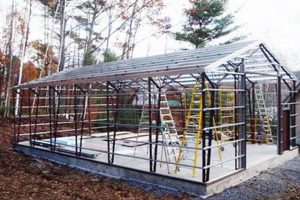Three-dimensional computer-aided design (CAD) software offers individuals a powerful toolset for realizing personal projects. This technology allows users to create detailed models of objects before physical construction, enabling precise planning and reducing potential errors. For example, a hobbyist designing a custom enclosure for electronic components can utilize this software to ensure proper fit and functionality prior to fabrication.
The significance of employing such software lies in its capacity to streamline the design process, enhance accuracy, and foster innovation. Historically, access to these capabilities was limited to professional engineers and designers within corporate settings. However, increased accessibility and affordability have empowered a broader range of individuals to engage in complex design endeavors, driving creativity and problem-solving in various domains.
This article will delve into the specific functionalities and advantages of using robust CAD platforms. It will explore available resources for learning these platforms, address the potential challenges encountered by new users, and examine case studies demonstrating successful applications across diverse fields.
Tips for Utilizing CAD Software in Personal Projects
Effective application of three-dimensional computer-aided design (CAD) software requires a strategic approach. The following guidelines are intended to optimize the design process and maximize the benefits of using this technology for personal projects.
Tip 1: Prioritize Parametric Modeling. Construct models using parameters to define key dimensions and relationships. This approach allows for easy modification and iterative design refinement without requiring complete model reconstruction.
Tip 2: Master Sketching Fundamentals. The accuracy and efficiency of sketches directly influence the quality of the final model. Dedicate time to learning constraints, relations, and efficient sketching techniques to create robust and adaptable base features.
Tip 3: Leverage Existing Libraries and Resources. Utilize online libraries for standard parts, components, and templates to reduce design time and ensure compatibility. Verify the accuracy and suitability of downloaded models before integration.
Tip 4: Implement Version Control. Maintain a clear versioning system for design files to track changes, revert to previous iterations, and prevent data loss. This is especially critical for complex projects involving multiple design phases.
Tip 5: Simulate and Analyze Designs. Employ integrated simulation tools to evaluate structural integrity, fluid dynamics, or thermal performance. This practice helps identify potential weaknesses and optimize designs for specific applications.
Tip 6: Optimize for Fabrication. Consider manufacturing constraints and limitations during the design phase. Account for material properties, machining tolerances, and assembly processes to ensure feasibility and minimize production costs.
Tip 7: Document Design Intent. Clearly annotate models with dimensions, tolerances, and notes to communicate design intent effectively. Detailed documentation facilitates collaboration and ensures future maintainability.
Adhering to these recommendations will enhance project outcomes and foster a more efficient workflow when employing CAD software. The consistent application of these techniques contributes to the successful realization of personal design endeavors.
The subsequent sections will address common troubleshooting scenarios and provide resources for advanced software utilization.
1. Accessibility
Accessibility represents a critical determinant in the widespread adoption and effective utilization of three-dimensional computer-aided design (CAD) software for do-it-yourself (DIY) projects. The ease with which individuals can access and afford such software directly impacts their ability to engage in digital design and fabrication processes.
- Cost of Software Licensing
The financial investment required to acquire a SolidWorks license poses a significant barrier for many DIY enthusiasts. While educational versions or student licenses may be available, their functionality might be restricted or time-limited. Furthermore, the cost of commercial licenses can be prohibitive for individuals operating on limited budgets, potentially steering them towards alternative, lower-cost, or open-source solutions, even if those solutions offer fewer features.
- Hardware Requirements
SolidWorks necessitates a computer system that meets specific hardware specifications to ensure optimal performance. Insufficient processing power, memory, or graphics capabilities can lead to slow performance, frequent crashes, and a frustrating user experience. Consequently, individuals may need to invest in upgraded hardware, increasing the overall cost of entry and potentially excluding those with older or less powerful computers.
- Availability of Training Resources
Accessible and comprehensive training resources are vital for enabling users to effectively learn and utilize SolidWorks. The presence of readily available tutorials, documentation, and community forums can significantly reduce the learning curve and empower individuals to overcome technical challenges. Conversely, a lack of adequate resources or a reliance on expensive, formal training programs can impede skill development and hinder widespread adoption.
- Integration with Other Tools and Platforms
The ability to seamlessly integrate SolidWorks with other software tools and fabrication platforms enhances its accessibility for DIY projects. Compatibility with 3D printers, CNC machines, and other manufacturing equipment allows individuals to translate digital designs into physical prototypes and finished products efficiently. Limited integration or the need for proprietary file formats can restrict users’ options and increase complexity, thereby reducing overall accessibility.
The interplay of these factors collectively defines the accessibility landscape surrounding SolidWorks for DIY applications. Addressing these barriers is crucial for democratizing access to advanced design and fabrication technologies, enabling a wider range of individuals to realize their creative visions.
2. Learning Curve
The learning curve represents a significant factor influencing the successful adoption of SolidWorks for do-it-yourself (DIY) projects. The steepness and duration of this curve directly correlate with the user’s initial investment of time and effort, ultimately determining their ability to effectively leverage the software’s capabilities for practical applications.
- Interface Complexity
SolidWorks presents a complex user interface characterized by numerou
s toolbars, menus, and dialog boxes. New users must navigate this intricate environment to locate and utilize specific functions. The lack of intuitive organization can result in a prolonged initial learning period as individuals familiarize themselves with the software’s structure. For instance, locating the correct feature for creating a simple extrude can require significant searching and experimentation, leading to frustration and delayed progress in project development. - Feature-Based Modeling
SolidWorks employs a feature-based parametric modeling approach. This paradigm necessitates understanding the sequential creation and modification of features to construct complex three-dimensional models. Novice users may struggle with the concept of parent-child relationships between features, leading to unpredictable results when attempting to modify existing designs. A poorly planned feature tree can render a model difficult to edit or adapt, highlighting the importance of mastering the underlying principles of feature-based modeling.
- Constraint Management
Accurate constraint management is essential for creating robust and adaptable models in SolidWorks. Users must apply appropriate geometric and dimensional constraints to define the relationships between various elements within a sketch or feature. Insufficient or incorrect constraint implementation can lead to model instability and unexpected behavior during modifications. Learning to effectively apply constraints requires a thorough understanding of geometric principles and the software’s constraint solver.
- Simulation and Analysis Tools
SolidWorks offers integrated simulation and analysis tools for evaluating design performance. However, utilizing these tools effectively requires a background in engineering principles and a familiarity with numerical methods. New users may find it challenging to interpret simulation results and make informed design decisions based on the analysis. Furthermore, setting up accurate simulation parameters and boundary conditions demands a degree of expertise that may exceed the capabilities of many DIY enthusiasts.
Addressing the learning curve associated with SolidWorks requires a commitment to structured learning and consistent practice. While the initial investment of time and effort can be substantial, mastering the software’s capabilities unlocks a powerful toolset for realizing complex and innovative DIY projects. The availability of comprehensive tutorials, online resources, and community support can significantly accelerate the learning process and empower users to overcome technical challenges.
3. Material Selection
Material selection is an integral aspect of any design process, particularly within the realm of do-it-yourself (DIY) projects utilizing three-dimensional computer-aided design (CAD) software. The properties of chosen materials directly influence structural integrity, functionality, and aesthetic appeal. Accurate representation of these properties within the digital design environment is crucial for predicting real-world performance and ensuring project success.
- Material Properties and Simulation
SolidWorks facilitates the assignment of material properties, such as density, tensile strength, and thermal conductivity, to virtual components. This allows for simulations to predict stress distribution, deformation under load, and thermal behavior. Inaccurate material property assignments can lead to flawed simulations and, consequently, unreliable physical prototypes. For example, selecting “generic plastic” instead of specifying the properties of ABS or PLA in a 3D printed enclosure can result in incorrect stress analysis and potential structural failure under operational conditions.
- Manufacturing Process Compatibility
The selected material must be compatible with the intended manufacturing process. SolidWorks designs destined for 3D printing require materials suitable for additive manufacturing, such as filaments or resins. Conversely, designs intended for CNC machining necessitate materials that can be milled or turned. Incompatibility between material selection and manufacturing process can lead to production difficulties, material waste, and compromised product quality. For instance, designing a complex part for injection molding in SolidWorks using a material that is not readily available or suitable for that process will result in manufacturing challenges.
- Cost Considerations
Material costs can significantly impact the overall budget of a DIY project. SolidWorks users must consider the price of materials when making design decisions, balancing performance requirements with budgetary constraints. Selecting a high-performance material for a non-critical component may be unnecessarily expensive, while opting for a cheaper material that lacks adequate strength or durability can compromise project integrity. For example, using titanium for a small bracket in a home automation system may be overkill compared to using aluminum or steel, depending on the load requirements.
- Aesthetic and Functional Requirements
Material selection also plays a crucial role in achieving the desired aesthetic and functional characteristics of the final product. SolidWorks models can be rendered with different material appearances to visualize the finished product. Furthermore, material properties like surface finish, color, and texture directly influence the user experience. For example, designing a furniture component using SolidWorks requires careful consideration of wood type, finish, and grain orientation to achieve the desired look and feel, while also ensuring structural stability and durability.
The interplay of these factors underscores the importance of deliberate material selection when utilizing SolidWorks for DIY projects. A comprehensive understanding of material properties, manufacturing processes, cost implications, and aesthetic requirements is essential for translating virtual designs into functional and visually appealing physical objects. Ignoring these considerations can lead to design flaws, manufacturing difficulties, and ultimately, project failure.
4. Design Complexity
Design complexity represents a pivotal factor in determining the suitability and effectiveness of SolidWorks for do-it-yourself (DIY) projects. The level of intricacy involved in a design directly influences the software’s required functionalities, the necessary skill set of the user, and the potential for successful realization of the project. Successfully navigating design complexity within the SolidWorks environment requires a deliberate approach, incorporating strategic planning and a thorough understanding of the software’s capabilities.
- Number of Components and Assemblies
The sheer quantity of individual parts and the complexity of their interrelationships within an assembly significantly impact design complexity. A simple project involving a few basic components requires a relatively limited skill set and can be managed efficiently within SolidWorks. Conversely, a complex assembly comprising hundreds of unique parts, each with intricate geometries and precise mating conditions, demands advanced modeling techniques and robust assembly management strategies. Consider, for example, the design of a mini
ature internal combustion engine. The large number of components, including pistons, valves, crankshafts, and connecting rods, each requiring precise tolerances and intricate geometries, necessitate a high degree of proficiency in SolidWorks to ensure proper functionality and interference-free operation. - Geometric Intricacy and Surfacing
The complexity of the shapes and surfaces that comprise a design directly correlates with the level of skill required to model them effectively in SolidWorks. Basic designs incorporating simple geometric primitives, such as cubes, cylinders, and extrusions, can be created relatively easily. However, designs that incorporate complex curves, sculpted surfaces, and organic forms demand advanced surfacing techniques and a thorough understanding of SolidWorks’ surfacing tools. The design of an aerodynamic aircraft wing, for instance, requires the creation of smooth, continuous surfaces that conform to precise aerodynamic profiles. This necessitates the use of advanced surfacing tools and a mastery of techniques such as lofting, sweeping, and boundary surface creation to achieve the desired performance characteristics.
- Functional Requirements and Simulation
The number and sophistication of functional requirements imposed on a design increase its complexity. A purely aesthetic design with no functional requirements is relatively straightforward to model in SolidWorks. However, designs that must withstand specific loads, operate within defined temperature ranges, or meet other performance criteria necessitate the use of simulation and analysis tools to validate their functionality. The design of a robotic arm, for example, requires consideration of factors such as load capacity, range of motion, and structural integrity. SolidWorks’ simulation tools can be used to analyze stress distribution, deflection under load, and thermal performance to ensure that the design meets the required specifications. This requires a thorough understanding of engineering principles and the proper application of simulation techniques.
- Manufacturing Constraints and Tolerances
Consideration of manufacturing constraints and tolerances adds another layer of complexity to the design process. Designs that are easy to manufacture and assemble generally involve simpler geometries and looser tolerances. However, designs that require tight tolerances or utilize complex manufacturing processes demand careful attention to detail and a thorough understanding of manufacturing principles. The design of a precision instrument, for example, requires consideration of factors such as machining tolerances, surface finish requirements, and assembly methods. SolidWorks’ tools for tolerance analysis and manufacturability assessment can be used to identify potential manufacturing issues and optimize the design for efficient production.
Navigating the multifaceted aspects of design complexity is crucial for leveraging the capabilities of SolidWorks in DIY projects. A realistic assessment of the project’s inherent complexity, coupled with a corresponding evaluation of the user’s skill level and available resources, is paramount for ensuring a successful outcome. Overestimating one’s capabilities or underestimating the inherent challenges can lead to frustration, wasted resources, and ultimately, project failure. Conversely, a well-planned and executed approach, incorporating appropriate design strategies and leveraging the full potential of SolidWorks’ tools, can enable the realization of even the most ambitious DIY endeavors.
5. Fabrication Methods
The effectiveness of utilizing SolidWorks for DIY projects is intrinsically linked to the chosen fabrication methods. The selection of a particular method directly influences the design parameters within SolidWorks, creating a cause-and-effect relationship between the digital model and its physical realization. For example, a design intended for 3D printing necessitates adherence to specific geometric constraints, such as minimum wall thickness and overhang angles, which must be considered during the modeling phase. Conversely, a design destined for CNC machining requires attention to tool accessibility, material removal strategies, and fixturing considerations, all of which impact the design approach within SolidWorks. Therefore, understanding the limitations and capabilities of the intended fabrication method is paramount for creating a manufacturable design using SolidWorks.
Fabrication methods represent a crucial component of the SolidWorks for DIY workflow, acting as the bridge between the virtual model and the tangible outcome. Consider the creation of custom electronic enclosures. If the chosen fabrication method is laser cutting acrylic, the SolidWorks design must account for kerf width, material thickness, and jointing techniques appropriate for laser-cut parts. Failure to accurately represent these factors in the SolidWorks model can result in parts that do not fit together correctly or are structurally unsound. Similarly, if the chosen method is casting metal components, the SolidWorks model needs to incorporate draft angles, parting lines, and shrinkage allowances to ensure successful mold creation and casting processes. This highlights the importance of aligning the SolidWorks design with the specific requirements of the fabrication method.
In summary, a comprehensive understanding of fabrication methods is essential for maximizing the benefits of SolidWorks for DIY projects. Accurate consideration of manufacturing processes during the design phase within SolidWorks enables the creation of functional, manufacturable, and aesthetically pleasing physical objects. Challenges may arise when dealing with unfamiliar fabrication techniques or complex geometries. Addressing these challenges requires diligent research, experimentation, and potentially consultation with experienced fabricators. Ultimately, the synergy between SolidWorks and appropriate fabrication methods empowers individuals to translate their digital designs into tangible realities.
6. Community Support
Community support networks function as indispensable resources for individuals engaged in three-dimensional computer-aided design (CAD) activities, particularly within the realm of do-it-yourself (DIY) projects. These networks provide avenues for knowledge sharing, collaborative problem-solving, and mutual assistance, substantially mitigating the challenges associated with software mastery and project implementation. The availability of such support directly influences the accessibility and usability of CAD platforms for individuals lacking formal engineering training.
The significance of community support can be illustrated through various examples. Online forums dedicated to specific CAD programs offer platforms for users to exchange tips and tricks, troubleshoot technical issues, and seek guidance on complex modeling tasks. These forums often contain extensive libraries of user-generated tutorials, sample models, and design templates, providing invaluable learning resources for novice users. In the context of DIY endeavors, individuals can leverage these resources to overcome design hurdles, optimize manufacturing processes, and validate the feasibility of their projects. For instance, a user encountering difficulties with creating a specific geometric feature can post their problem on a forum and receive step-by-step instructions from experienced users. Sim
ilarly, individuals seeking to integrate CAD models with specific fabrication equipment can benefit from the collective knowledge of the community in addressing compatibility issues and optimizing toolpaths. Furthermore, organized groups, both online and local, foster collaboration through shared projects, workshops, and mentorship opportunities. These avenues can be a significant source of help when applying CAD software.
In conclusion, the presence of robust community support networks serves as a catalyst for fostering a more inclusive and accessible CAD ecosystem. By providing readily available resources, expert guidance, and collaborative opportunities, these networks empower individuals to overcome technical challenges, enhance their skills, and realize their creative visions. The recognition and cultivation of community support are paramount for maximizing the benefits of CAD platforms and promoting innovation across various DIY domains. Challenges may arise with misinformation or overwhelming the community with basic questions. Addressing this could be mentorship programs or curated FAQ.
Frequently Asked Questions
The following addresses common inquiries regarding the utilization of SolidWorks in do-it-yourself projects. These questions aim to provide clarity and guidance for prospective users considering employing this powerful software.
Question 1: Is prior engineering experience mandatory to utilize SolidWorks effectively for DIY projects?
While a formal engineering background can be beneficial, it is not strictly required. A basic understanding of geometric principles, spatial reasoning, and manufacturing processes is advantageous. SolidWorks offers numerous tutorials and resources to facilitate learning for individuals without formal training. Furthermore, community support forums provide assistance in navigating complex design challenges.
Question 2: What are the minimum system requirements to run SolidWorks adequately?
SolidWorks demands a computer system meeting specific hardware specifications for optimal performance. At a minimum, a dedicated graphics card, a multi-core processor with a high clock speed, and sufficient RAM (typically 16GB or more) are recommended. Insufficient hardware can lead to slow performance and software instability.
Question 3: Is a paid SolidWorks license necessary, or are there alternative acquisition methods?
A commercial SolidWorks license entails a significant financial investment. However, educational versions or student licenses may be available at reduced costs, albeit potentially with functional limitations or time restrictions. Open-source CAD alternatives exist, but their feature sets and compatibility with SolidWorks files may vary.
Question 4: How does SolidWorks facilitate the integration of designs with 3D printing or CNC machining workflows?
SolidWorks supports the export of designs in various file formats compatible with 3D printers and CNC machines, such as STL and STEP. Furthermore, it offers tools for simulating manufacturing processes and optimizing designs for manufacturability. Careful consideration of manufacturing constraints during the design phase is crucial for seamless integration.
Question 5: What level of precision and accuracy can be expected when translating SolidWorks designs into physical objects?
The precision and accuracy of the final product depend on several factors, including the accuracy of the SolidWorks model, the capabilities of the chosen manufacturing process, and the material properties. Adherence to proper design practices, precise dimensioning, and appropriate tolerance settings are essential for achieving desired results.
Question 6: What are the common pitfalls to avoid when using SolidWorks for DIY projects?
Common pitfalls include neglecting to consider manufacturing constraints, failing to properly constrain sketches, creating overly complex geometries, and ignoring material properties. A thorough understanding of SolidWorks’ functionalities and a strategic approach to design are essential for mitigating these issues.
In conclusion, SolidWorks offers a powerful toolset for realizing complex DIY projects. A strategic approach, coupled with adequate learning and resource utilization, is essential for successful implementation.
The next article will look into the future of “solidworks for diy”.
SolidWorks for DIY
This exploration of SolidWorks for DIY has illuminated its potential and inherent complexities. The capacity for precise modeling, simulation, and design optimization offers significant advantages for individuals undertaking diverse projects. However, factors such as software cost, learning curve, and fabrication method integration must be carefully considered to ensure effective implementation. Accessible resources, community support, and a strategic approach to design are critical for navigating these challenges and maximizing the software’s benefits.
Ultimately, the value of SolidWorks for DIY rests on the user’s ability to balance its advanced capabilities with practical considerations and a commitment to continuous learning. As technology evolves and accessibility improves, its role in empowering individual innovation and personalized fabrication will likely expand, transforming how personal projects are conceived, designed, and realized. The diligent application of knowledge, coupled with a focus on overcoming obstacles, will unlock the full potential of this tool and shape the future of DIY design and manufacturing.







